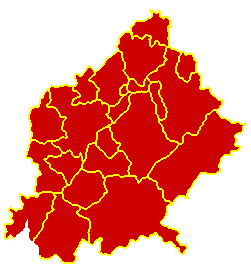
RIBATEJO
MY HOMELAND
THE FIRST UNNOFICIAL PAGE
Little clarification to the beloved people 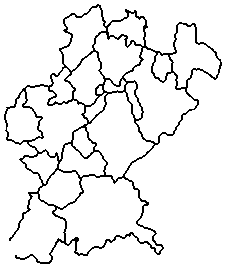
Attention! Ribatejo (left) is not, as many think, the District of Santarém (right). Supposedly, it should be the latter with the municipalities of Azambuja, Ponte de Sor and Vila Franca de Xira, and without the municipalities of Ourém and Mação. |
||
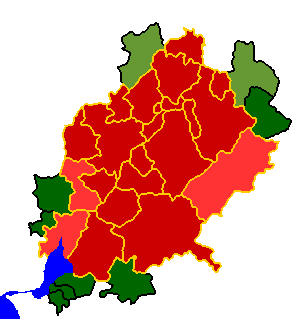 |
||
| Municipalities inside Ribatejo and inside District of Santarém | ||
| Municipalities inside Ribatejo and outside District of Santarém | ||
| Municipalities outside Ribatejo and inside District of Santarém | ||
| Municipalities outside Ribatejo and outside District of Santarém, with cultural similarities | ||
| Adapted from "Popular Religion in Ribatejo" by Aurélio Faria, Ma. Sc. Soc. | ||
Anyway, and outside any borderly boundaries,
|
||
A Little Ribatejan Postcard |
||||||||||||
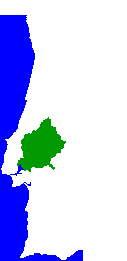
Welcome to one of the most beautiful regions in the world. Situated exactly in the middle of Portugal, has one of the most unique landscapes you've imagined (I think I'm sounding too much like a tourist guide. Well, carry on.). To start, take a look at the beautiful Tejo river (or,
as you call it, Tagus), as seen from the walls of the
Portas do Sol (Gates of the Sun) Garden in Santarém, the
province capital. |
||||||||||||
|
It's not always like in the picture. In fact, it's a
shame that the river has so much sand, that little
islands have developed in the middle, growing vegetation
and all. Most of the water is retained in the large number of dams (7 only in the Spanish side) that were built (it's the longest river of the Iberian Peninsula) so, when the water reaches here, it has no strength to wash away the sand that it carries. The positive side in this is the widening of the river beaches, even if their touristic potential is not yet explored.
BUT DON'T GROW DESPERATE! In some places, local authorities have opened their eyes
to this resource and built very enjoyable little resorts! YIPPEE! As tourism is developing, sand extraction zones are being more properly signed or surrounded by fences (see box). |
In the past, the biggest problem for those going to the river beaches was sand extractions works. The sand is widely used in house construction due to its qualities, but the
constructors prefer to extract from the margins then from
the inside of the river. Some people were caught in the depressions that
are created, risking to drown (this is true - doesn't
sound nice having to say it, but better safe than
sorry!). Even I was caught once! It's really stupid that such a Nature-given resource is so badly used... In other countries, it would become a major tourism resource. But, then again, it could be like Italy, where you can't stay in a beach without paying for it...
|
|||||||||||
You can guess really clearly from the picture where the river stands. About the weather, well, expect hot Summers (yes, REALLY hot, ideal to get a nice tan! J ), and not-so-mild Winters. Although it never snows, it can be very unpleasant. In short, it's best to visit in July and August, and enjoy the fresh shadow of the weeping willow, while now and then falling in the calm waters of the river. Believe me, in some aspects, it can resemble the Bahamas (come and see for yourself)! |
||||||||||||
In the large properties where bulls are raised, comes out the one who shows how ties between Man and Nature is still strong: the Campino, or, as I heard (and laughed, and laughed), the "Portuguese cowboy".
With his colourful costume, he is the one that is in the field, taking care of the bulls on the back of his horse. Impressive, figure, no? You can see them (besides here, of course) in the several festivals that we have in the region, such as: 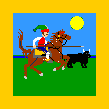
Another typical figure is the Forcado, who is the man that takes the bull by the horns in the bullfights. I am not here to discuss if it's ethical or not to
have bullfights. I was raised watching them, and I see
them as part of the Iberian Peninsula culture, period. |
||||||||||||
So, you were asking about the food?
Not satisfied yet? This is only a tiny sample of what
you can find in the richness of the Ribatejan Cuisine.
By the way, you wouldn't expect for me to write this all
in one time. I could not control myself and... To go with all that? Well, the product of these vineyards, the regional wine, of course! After all, this is the biggest zone of production in Portugal. Oh, my God, the wine... The reds are strong and full-bodied, the whites are sweet, and deceiving. They go down trough the throat like water that when you notice you are already drunk!!! That's sort of what happened to me (hehehe)! No joke, they have between 11 and 15 degrees (24 and 30 proof)!!! Some producers even provide guided tours to their wine works, where you can learn more about the production, storing and aging processes, and the visits ends by (naturally) a session of wine tasting. |
||||||||||||
The Campino Suit
A true
Campino does not wear rist-watch, rather has his "onion" in the "colete" (waistcoat)-in
the picture covered by the "jaqueta" (coat)-attached to the interior of the "colete"
by a metal chain. The golden element in the "colete" (covered by the "jaqueta") is the emblem of the "Casa Agrícola" (Estate) where the campino works. It is the brand which identifies the cattle owned by the Estate. |
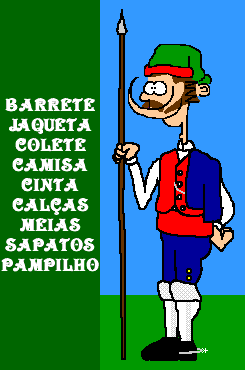
|
|||||||||||
The Forcado Suit
So, the "Moço de Forcado" (Forcado boy) was the user of that "spear with
ball-pointed horns", usually a young campino aspirant, or another "foot worker"
of the "Casa Agrícola". From here to name them only "Forcado" was a small
step towards simplification".
Nowadays one can find them only in bullfights, taking the bulls by the horns. One can tell from which Group
they come from the colour and drawings of the "jaqueta"-intricated designs, in
colourful motifs of rare beauty. |
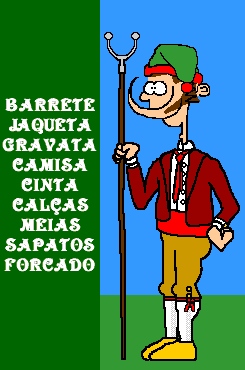
|
|||||||||||
The Ribatejan HouseBy definition, the Ribatejan house is simple, ground-floor, whiotewashed,
with the bords of the windows and doors painted in ocre. It is also rather
common to find that border in brick-red or dark blue. Also common is that the
roofs are conjoined.
|
||||||||||||
BELIEVE ME, IT IS WORTH A VISIT!
|
||||||||||||
Other resources to check for information:
|
||||||||||||
|
||||||||||||
Comments? Great!
Write back to André Filipe Marques Serranho at
[email protected]
You will be replied ASAP, that's for sure!!!
Copyright © 1997-2003 André Filipe Marques Serranho
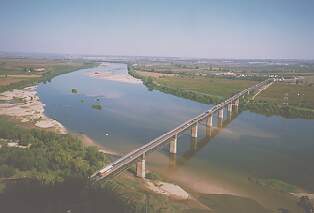
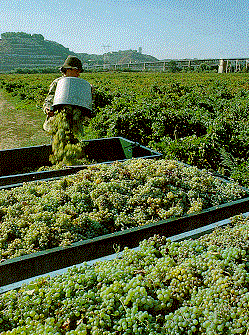
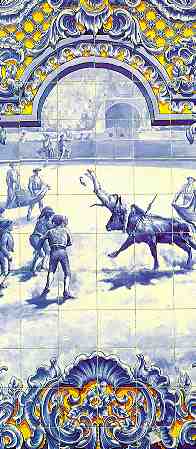


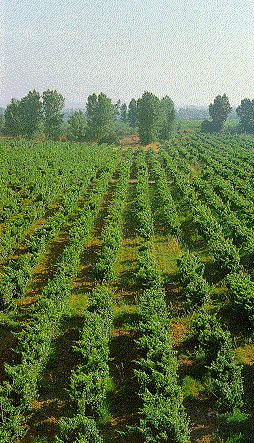

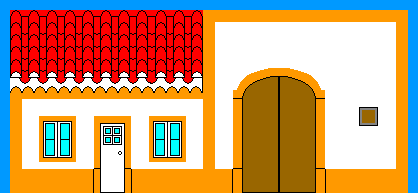 Sometimes, the house has a siden entrance, closed in an arch, that is (was) an
entrance for wagons or agricultural machines into the cellar.
Sometimes, the house has a siden entrance, closed in an arch, that is (was) an
entrance for wagons or agricultural machines into the cellar.
